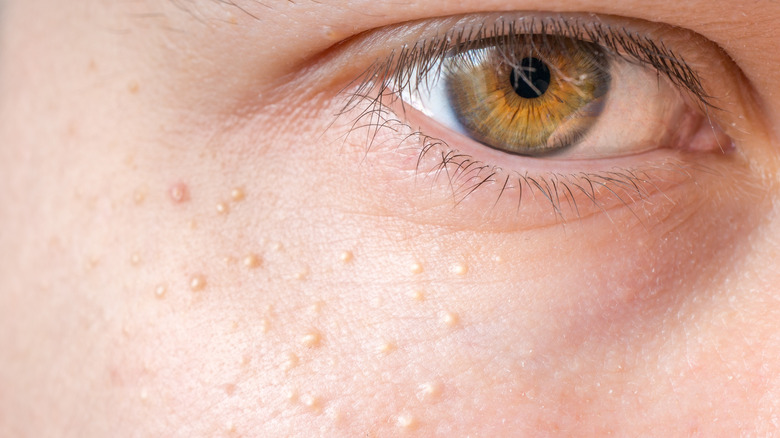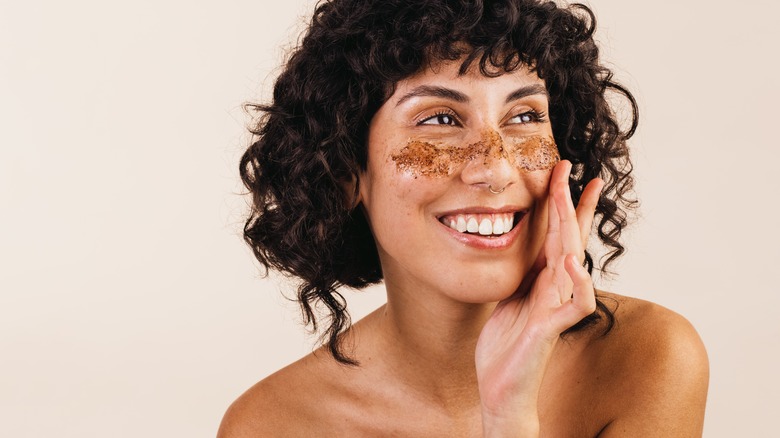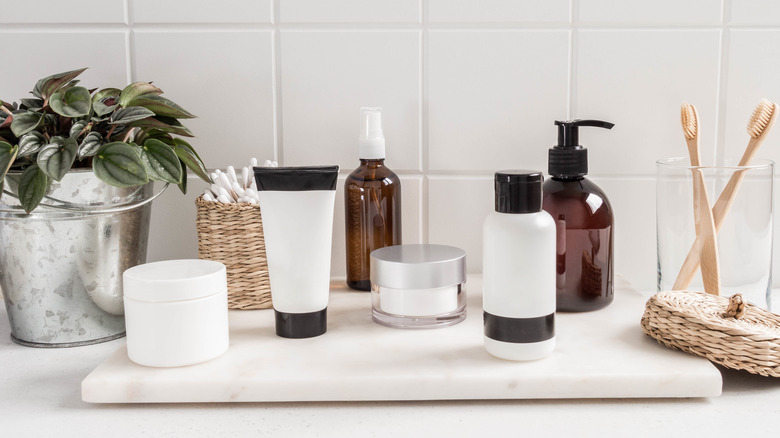Here's How To Get Rid Of Milia Under Your Eyes
We may receive a commission on purchases made from links.
On the path to achieving smooth, radiant skin, it always seems that there are bumps in the road. In some cases, the bumps come in the form of, well, literal bumps. Milia, also known as milk spots, are tiny, white cysts that come from keratin being trapped under the skin (via Healthline).
The bumps are often found on newborn babies but can appear on older kids and adults, particularly underneath the eyes. Milia is by no means harmful or dangerous; however, they can be itchy or cause raised patches on your skin.
Since they don't pose a threat to your health, there's no need to stress about removing them. Milia can often go away on their own since they're potentially formed by not washing your face, clogged pores, or not getting enough sleep, according to WebMD. However, if you want to remove them, there are steps you can take.
A dermatologist or esthetician can give you cryotherapy or laser ablation to get rid of the milia. During cryotherapy, liquid nitrogen freezes the cysts, helping to eradicate them. With laser ablation, which isn't a safe option for darker skin tones, lasers break down the keratin so the skin can absorb it.
Exfoliating and moisturizing is the key to busting milia
According to Groupon, a single cryotherapy session can cost anywhere from $60-100. If you're not willing to drop the cash on those treatments, creating a skincare routine that targets milia will help to remove the keratin-filled cysts.
In general, exfoliating products and certain acids can help decrease milia, according to Stylist. Exfoliating helps with skin cell turnover and removes the top layer of dead skin. When done consistently, you'll start to see that the milia go away. A gentle physical exfoliator or AHAs and BHAs such as lactic, salicylic, or glycolic acid will help get rid of milia.
Retinol is also another milia-killer, says the Dermstore. A small layer applied nightly or every other night, along with some moisturizer, will help to unclog pores and increase the production of skin cells, effectively whittling away milia.
For irritated or red milia, gentle, anti-inflammatory ingredients are the key to calming them down. Manuka honey helps to reduce and prevent inflammation, calming the skin down and offering relief. Milia can also be caused by dry skin cells that join together, causing the cyst. Manuka honey is not only soothing, but moisturizing as well, so it can help with the dryness that worsens milia.
Skincare products that will help you get rid of milia
The Andalou Naturals Pumpkin Honey Glycolic Mask is a two-in-one milia-busting product. It is formulated with glycolic acid that works to dissolve dead skin cells and manuka honey, which has moisturizing and healing properties. The mask also contains fruit stem cells, which are high in antioxidants and help with cell renewal and circulation.
Rather than applying retinol and then following up with a moisturizer, use Paula's Choice Resist Intensive Repair Cream with Retinol. The anti-aging cream has .01% retinol, which is a low-strength dosage, great for more sensitive skin. The hydrating moisturizer contains peptides, which ward off inflammation and reduces the appearance of dark spots.
The La Roche-Posay Effaclar Medicated Gel Cleanser contains salicylic acid, exfoliating the skin to gently get rid of milia. The acid also decreases excess oil on the skin, which can cause milia by clogging pores. Despite the fact that the Effaclar cleanser targets oil, it doesn't dry out the skin; it contains glycerin, a humectant that keeps skin hydrated.


